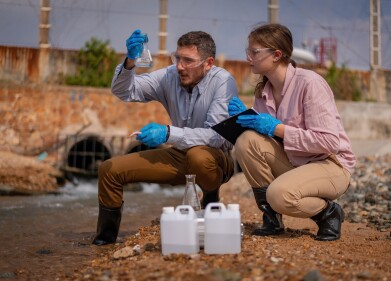Water/wastewater
How Do We Monitor the Pollutants Produced by Desalination?
Feb 14 2023
Monitoring the pollutants that result from desalination is critical for ensuring that the process is carried out in an environmentally sustainable manner. There are several instruments that are commonly used to monitor pollutants in the marine environment, including chemical sensors, optical sensors, and biological indicators.
Chemical sensors are used to measure the concentration of various pollutants in the water, including heavy metals, organic matter, and pathogens. These sensors can be deployed in real-time, providing continuous monitoring of water quality, and can be used to detect changes in water quality over time. Some chemical sensors are also capable of measuring multiple parameters simultaneously, which can help to provide a more comprehensive picture of water quality.
Optical sensors are also commonly used to monitor pollutants in the marine environment. These sensors use light to measure the concentration of various substances in the water, including dissolved oxygen, pH, and chlorophyll. Optical sensors can be used to monitor the impacts of pollutants on aquatic life, including changes in the health and behaviour of marine organisms.
Biological indicators, such as phytoplankton, zooplankton, and benthic invertebrates, are also used to monitor pollutants in the marine environment. These indicators can provide information on the overall health of the ecosystem, and can help to detect changes in water quality over time. For example, changes in the abundance and diversity of phytoplankton can indicate the presence of pollutants that are harmful to aquatic life.
In addition to these instruments, there are also various remote sensing technologies that can be used to monitor pollutants in the marine environment. These technologies, including satellites, drones, and autonomous underwater vehicles, can provide information on a wide range of environmental parameters, including water temperature, salinity, and ocean currents. Remote sensing technologies can also be used to detect changes in the distribution and abundance of marine life, providing early warning signs of environmental degradation.
To effectively monitor the pollutants that result from desalination, it is important to use a combination of these different instruments and technologies. By using multiple methods, it is possible to get a more comprehensive and accurate picture of the impacts of desalination on the marine environment.
In conclusion, the instruments used to monitor the pollutants that result from desalination are critical for ensuring that the process is carried out in an environmentally sustainable manner. By using a combination of chemical sensors, optical sensors, biological indicators, and remote sensing technologies, it is possible to get a comprehensive and accurate picture of the impacts of desalination on the marine environment, and to make informed decisions about how best to minimize these impacts.
Digital Edition
IET 35.2 March
April 2025
Air Monitoring - Probe Sampling in Hazardous Areas Under Extreme Conditions - New, Game-Changing Sensor for Methane Emissions - Blue Sky Thinking: a 50-year Retrospective on Technological Prog...
View all digital editions
Events
Apr 21 2025 Shanghai, China
Apr 22 2025 Hammamet, Tunisia
Apr 22 2025 Kintex, South Korea
Analytica Anacon India & IndiaLabExpo
Apr 23 2025 Mumbai, India
Apr 23 2025 Moscow, Russia



















